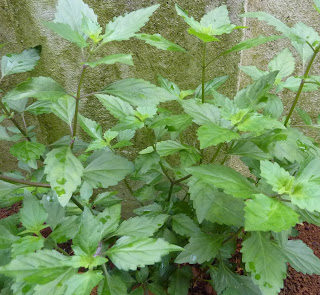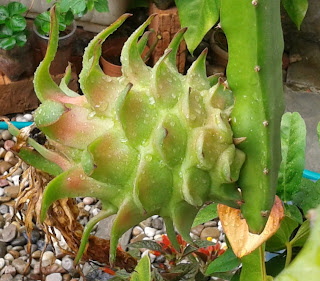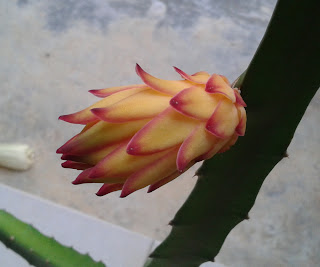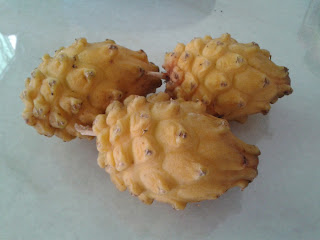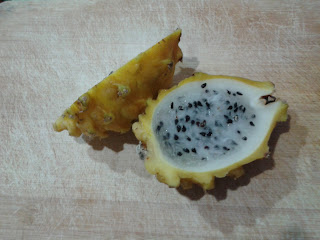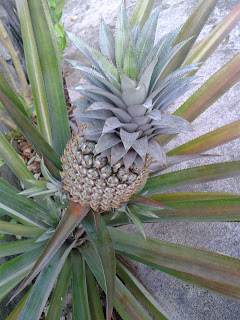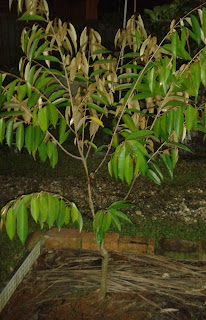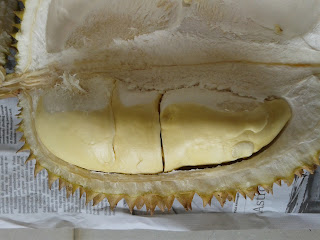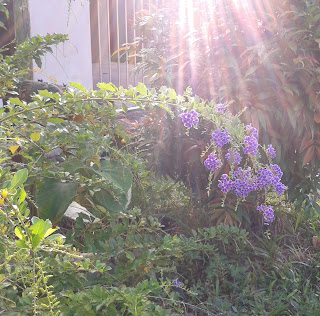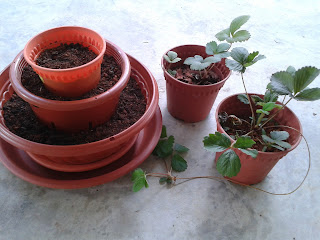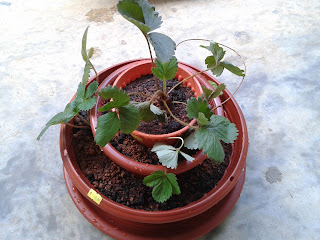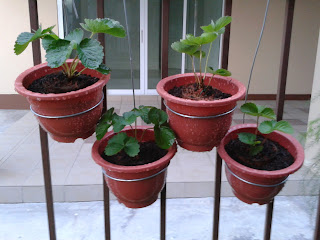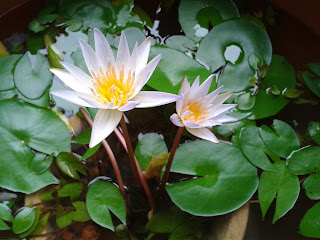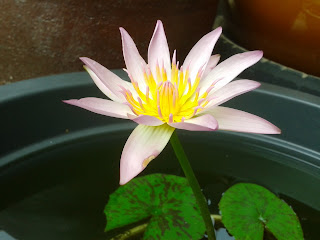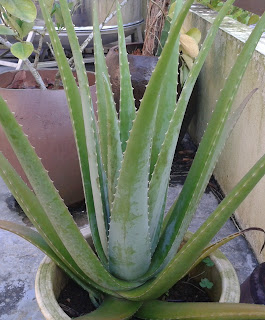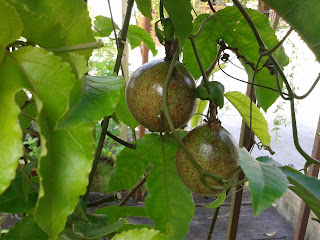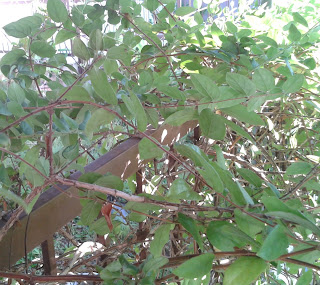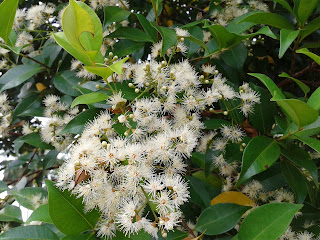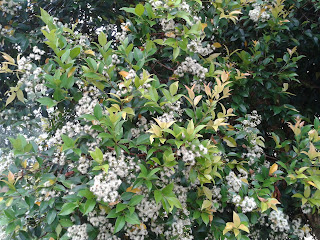Penny Wort / Daun Pegaga / Centella asiatica
http://en.wikipedia.org/wiki/Pegaga
Excerpt from Wikipedia...
Culinary use
Centella is used as a leafy green in Sri Lankan cuisine, where it is called Gotu Kola. In Sinhalese Gotu is translated into conical shape and Kola for leaf. It is most often prepared as malluma (මැල්ලුම); a traditional accompaniment to Rice and curry, and goes especially well with vegetarian dishes such as dhal, and jackfruit or pumpkin curry. It is considered quite nutritious. In addition to finely chopped Gotu Kola, malluma almost always contains grated coconut and may also contain finely chopped green chilis, chili powder, turmeric powder and lime (or lemon) juice.
A variation of the extremely nutritious porridge known as Kola Kenda is also made with Gotu Kola by the Sinhalese people of Sri Lanka. Kola Kenda is made with very well boiled red rice (with extra liquid), coconut milk and Gotu Kola which is liquidized. The porridge is accompanied with Jaggery for sweetness. Centella leaves are also used in the sweet "pennywort drink."
In Indonesia, the leaves are used for sambai oi peuga-ga, an Aceh type of salad, also mixed into asinan in Bogor.
In Vietnam and Thailand, this leaf is used for preparing a drink or can be eaten in raw form in salads or cold rolls. In Bangkok, vendors in the famous Jatujak Market sell it alongside coconut, roselle, crysanthemum, orange and other health drinks.
In Malay cuisine the leaves of this plant are used for ulam, a type of Malay salad.[3]
It is one of the constituents of the Indian summer drink "thandaayyee".
Medicinal effects
Gotu kola is a mild adaptogen, is mildly antibacterial, anti-viral, anti-inflammatory, anti-ulcerogenic, anxiolytic, a cerebral tonic, a circulatory stimulant, a diuretic, nervine and vulnerary.[4][5]
Centella asiatica may be useful in the treatment of anxiety and may be used as a promising anxiolytic agent in the future.[6]
In Thailand cups with gotu kola leaves are used as an afternoon stimulant.[7] A decoction of juice from the leaves is thought to relieve hypertension.[citation needed] A poultice of the leaves is also used to treat open sores.
Richard Lucas claimed in a book published in 1966 [8](second edition in 1979) that a subspecies "Hydrocotyle asiatica minor" allegedly from Sri Lanka also called "Fo ti tieng", contained a longevity factor called 'youth Vitamin X' said to be 'a tonic for the brain and endocrine glands' and maintained that extracts of the plant help circulation and skin problems.[9] However according to medicinal herbalist Michael Moore, it appears that there is no such subspecies and no Vitamin X is known to exist.[10]
Several scientific reports have documented Centella asiatica's ability to aid wound healing[11],[12] which is responsible for its traditional use in leprosy. Upon treatment with Centella asiatica, maturation of the scar is stimulated by the production of type I collagen. The treatment also results in a marked decrease in inflammatory reaction and myofibroblast production.[13]
The isolated steroids from the plant have been used to treat leprosy.[14][15] In addition, preliminary evidence suggests that it may have nootropic effects.[16] Centella asiatica is used to re-vitalize the brain and nervous system, increase attention span and concentration,[17] and combat aging.[16] Centella asiatica also has anti-oxidant properties.[4] It works for venous insufficiency.[18] It is used in Thailand for opium detoxification.
Followers of Sri Sri Thakur Anukulchandra commonly known as Satsangees all over the world take one or two fresh leaves with plenty of water in the morning after morning rituals. This is prescribed by Sri Sri Thakur Himself.
'There have been many reports showing the medicinal properties of C. asiatica extract in a wide range of disease conditions like diabetic microangiopathy, edema, venous hypertension, venous insufficiency (Incandela et al., 2001a; Incandela et al., 2001b; Incandela et al., 2001c). The role of C. asiatica extract in the treatment of memory enhancement and other neurodegenerative disorders is also well documented (Mohandas Rao et al., 2006). The first report concerning the antitumor property of C. asiatica extract was on its growth inhibitory effects on the development of solid and ascites tumor and that lead to increased life span of the tumor bearing mice (Babu et al., 1995). The authors also suggested that the extract directly impeded the DNA synthesis. In our study, C. asiatica extract showed an obvious dose dependent inhibition of cell proliferation in breast cancer cells'[19]
Just another small fry scalping for pittance in a sea of sharks. ikan bilis main kupiao was originally to log kupiao matters of interest, but now houses what-not of interest.
Friday 30 December 2011
Monday 26 December 2011
Flora : Misai Kuching
Misai Kuching
You harvest the top two fully developed "leaves sets" and brew tea with it.
Very easy to propagate from cuttings. Just stick the cuttings into soil and water them. The cuttings will strike roots within a week.
You harvest the top two fully developed "leaves sets" and brew tea with it.
Very easy to propagate from cuttings. Just stick the cuttings into soil and water them. The cuttings will strike roots within a week.
Friday 23 December 2011
Flora : Dragon fruit
Dragon fruit
Red pitaya (Hylocereus costaricensis)
The evening before then bloom.
Flower blooms for a single night; hand polinate for maximum fruit size.
30 days from fruit set to harvest.
350g ~ 400g maximum weight per fruit.
Heart breaking... dropped flowers.
Yellow pitaya (Hylocereus megalantus)
1.5 years old yellow pitaya plant germinated from seed.
Saturday 17 December 2011
Thursday 15 December 2011
Flora : Durian
Durian
The king of fruits - either you love it, or you hate it.
The king of fruits - either you love it, or you hate it.
1.5 years old tree; another 3 years to go...
How to choose good durian?
Simple ;)
- fruit's shape
- thorns' appearance
- weight's appropriate-ness
- smell
... or just ask the seller to "pau ciak", pry it open on the spot. No "pau", don't buy.
Tuesday 13 December 2011
Flora : Duranta
Duranta ?
Not sure if this flower falls under duranta family. It's flowering behaviour is similar to duranta but does not produces the round, golden coloured fruits. The fruits are longish and smaller than duranta's. But one thing it does well is attracting lots of bees in the morning.
Not sure if this flower falls under duranta family. It's flowering behaviour is similar to duranta but does not produces the round, golden coloured fruits. The fruits are longish and smaller than duranta's. But one thing it does well is attracting lots of bees in the morning.
Sunday 11 December 2011
Flora : Strawberry
Strawberry
Species 1. The fruit is roundish, flower stalk is short. Fruits ripen within a week from setting.
Species 2. The fruit is longish, flower stalk is long. Fruits take more than a week to ripen.
Wild strawberry.
Easy to grow. Fruits are small and tasteless.
A three-tiers shoe-string budget strawberry planter project:
(Species 2 strawberry plants)
Ended up a disaster. The new location in the shaded car porch was too hot/dry (even though shaded). I lost the two mother plants but manage to save the daughter plant when I move the planter pot back to the former shady spot under a shrub with filtered sunlight.
I am still coaxing the surviving daughter plant to thrive and produce runners.
A hanging strawberry planters project:
(Species 1 strawberry plants)
The idea of having the strawberry plants high up from ground, free from snails and millipedes infestation sounds great, but ended up a disaster. The exposed sunny location is just unbearable. The leaves were getting burned and withering. Moving the pots to a more shaded spot under my passion fruit canopy also did not help. Lost all plants. Luckily I still have the mother plants snucked away in a corner under dense foliage.
After having 2 experimental disasters, I will KIV the idea of having rows of strawberry plants laden with yummy red fruits in my garden. Well, at least under my fruit trees are more mature to provide sufficient covers.
Cool micro-climate is a MUST it seems, with exposure to the morning dew and rain. So shaded car porch is a no-no.
16 Dec 2011
Flora : Water lily
Water lily
Waterlily is an alluring plant when in full bloom; bright petals emerging out of the murky depth, inviting you to take a closer look.
One might think planting water lily is as simple as sticking a plant into muddy water and leave it alone. Well..., unless that muddy water happens to be of correct depth, with correct amount of nutrient, exposed to full sun, and with water organisms to control water vectors (spelled m. l-a-r-v-a-e).
Water lily requires full sun.
Under full shade it will just wither back and dies.
Partial sun is ok, but after a while you will notice the plant growth biasing towards the sun. It will not wither and dies nor will it profusely grow and bloom. In the monsoon season when Mr. Sun can hide behind clouds for days and the frogs come out to sing, the less established plants can start withering.
Water lily needs regular fertiliser feeding in the right amount. Too much fertiliser and the water will turn murky green with algae growth. Too little fertiliser will result in stagnant growth or even some leaves to die back.
With sun and fertiliser requirements taken care of, you will need aquatic organisms to control mosquito larvaes. In a small confined setting, fish is not a good choice. However, prawns/shrimps will thrive happily. An advantage of prawns is they eat algae. They eat almost anything in the water that does not eat them.
Occasionally, prawns will even share the space with tadpoles.
Water lily is propagated via plantlets produced at the stem end of the leaves.
"Pamela" water lily - this is a dwarf species with purplish blooms.
"????" water lily - this is a mid-dwarf species with red blooms.
Rescued from certain doom after placing it under full shade out of ignorance. I manage to coax two new plantlets out of the withering leaves.
A frog decided to call home.
(After the putty kat decided to quit hunting frogs, the frogs are back with vengence. Breed and prosper, Kermit.)
11-Dec-2011
Waterlily is an alluring plant when in full bloom; bright petals emerging out of the murky depth, inviting you to take a closer look.
One might think planting water lily is as simple as sticking a plant into muddy water and leave it alone. Well..., unless that muddy water happens to be of correct depth, with correct amount of nutrient, exposed to full sun, and with water organisms to control water vectors (spelled m. l-a-r-v-a-e).
Water lily requires full sun.
Under full shade it will just wither back and dies.
Partial sun is ok, but after a while you will notice the plant growth biasing towards the sun. It will not wither and dies nor will it profusely grow and bloom. In the monsoon season when Mr. Sun can hide behind clouds for days and the frogs come out to sing, the less established plants can start withering.
Water lily needs regular fertiliser feeding in the right amount. Too much fertiliser and the water will turn murky green with algae growth. Too little fertiliser will result in stagnant growth or even some leaves to die back.
With sun and fertiliser requirements taken care of, you will need aquatic organisms to control mosquito larvaes. In a small confined setting, fish is not a good choice. However, prawns/shrimps will thrive happily. An advantage of prawns is they eat algae. They eat almost anything in the water that does not eat them.
Occasionally, prawns will even share the space with tadpoles.
Water lily is propagated via plantlets produced at the stem end of the leaves.
"Pamela" water lily - this is a dwarf species with purplish blooms.
"????" water lily - this is a mid-dwarf species with red blooms.
Rescued from certain doom after placing it under full shade out of ignorance. I manage to coax two new plantlets out of the withering leaves.
A frog decided to call home.
(After the putty kat decided to quit hunting frogs, the frogs are back with vengence. Breed and prosper, Kermit.)
11-Dec-2011
Sunday 13 November 2011
Flora : Lady of the night
Lady of the night / Xue Lai Xiang
Lady-of-the-night is a flowering shrub, so named because the flowers bloom only at night. There are a few variants but commonly known as lady of the night.
A vigorous growing plant, it will quickly grow into a small tree size (2~3 meters high with equal spread) if left unpruned. The branches should be nipped at the tip when it is 1~2 feet long to encourage branching for a more bushy plant. Flower stalks are produced along the new branches. Once a branch is exhausted, it need to be pruned back to maintain the plant's size.
The plant thrives in moist, compost rich soil; under full sun or partial shade. Propagation is by green wood cuttings.
The flowers are sweet smelling. In a still night with occasional mild breeze, you can whiff the sweet scent from meters away. But the scent sweetness can be erratic, and of different strength. Cuttings should be made from a proven mother plant of desired traits; i.e. mild sweetness vs. heavily sweet; consistent scent for every flower stalk... or check out another variant/species which may better suit your liking.
Lady-of-the-night is a flowering shrub, so named because the flowers bloom only at night. There are a few variants but commonly known as lady of the night.
A vigorous growing plant, it will quickly grow into a small tree size (2~3 meters high with equal spread) if left unpruned. The branches should be nipped at the tip when it is 1~2 feet long to encourage branching for a more bushy plant. Flower stalks are produced along the new branches. Once a branch is exhausted, it need to be pruned back to maintain the plant's size.
The plant thrives in moist, compost rich soil; under full sun or partial shade. Propagation is by green wood cuttings.
The flowers are sweet smelling. In a still night with occasional mild breeze, you can whiff the sweet scent from meters away. But the scent sweetness can be erratic, and of different strength. Cuttings should be made from a proven mother plant of desired traits; i.e. mild sweetness vs. heavily sweet; consistent scent for every flower stalk... or check out another variant/species which may better suit your liking.
Saturday 5 November 2011
Flora : Aloe Vera
Aloe Vera
http://en.wikipedia.org/wiki/Aloe_vera
Claims of medical properties
Scientific evidence for the cosmetic and therapeutic effectiveness of aloe vera is limited and when present is frequently contradictory.[2][3] Despite this, the cosmetic and alternative medicine industries regularly make claims regarding the soothing, moisturizing, and healing properties of aloe vera, especially via Internet advertising.[4][39][40][41][42] Aloe vera gel is used as an ingredient in commercially available lotions, yogurt, beverages, and some desserts.[43][44][45]
Aloe vera juice is used for consumption and relief of digestive issues such as heartburn and irritable bowel syndrome, although it bears significant potential to be toxic when taken orally.[46] It is common practice for cosmetic companies to add sap or other derivatives from Aloe vera to products such as makeup, tissues, moisturizers, soaps, sunscreens, incense, shaving cream, and shampoos.[43] Other uses for extracts of aloe vera include the dilution of semen for the artificial fertilization of sheep,[47] use as fresh food preservative,[48] and use in water conservation in small farms.[49] The supposed therapeutic uses of Aloe vera are not exclusive to the species and may be found to a lesser or greater degree in the gels of all aloes, and indeed are shared with large numbers of plants belonging to the family Asphodelaceae. Bulbine frutescens, for example, is used widely for the treatment of burns and a host of skin afflictions.[50]
Aloe vera has a long association with herbal medicine, although it is not known when its medical applications were first suspected. Early records of Aloe vera use appear in the Ebers Papyrus from 16th century BC,[16] in both Dioscorides' De Materia Medica and Pliny the Elder's Natural History written in the mid-first century CE[16] along with the Juliana Anicia Codex produced in 512 AD.[43] Aloe vera is non-toxic, with no known side effects, provided the aloin has been removed by processing. Taking aloe vera that contains aloin in excess amounts has been associated with various side-effects.[4][5][51] However, the species is used widely in the traditional herbal medicine of China, Japan, Russia, South Africa, the United States, Jamaica, Latin America and India.[4]
Aloe vera may be effective in treatment of wounds.[5] Evidence on the effects of its sap on wound healing, however, is limited and contradictory.[5] Some studies, for example, show that aloe vera promotes the rates of healing,[52][53] while, in contrast, other studies show that wounds to which aloe vera gel was applied were significantly slower to heal than those treated with conventional medical preparations.[54][55] A more recent review (2007) concludes that the cumulative evidence supports the use of aloe vera for the healing of first to second degree burns.[56] In addition to topical use in wound or burn healing, internal intake of aloe vera has been linked in preliminary research with improved blood glucose levels in diabetics,[57][58] and with lower blood lipids in hyperlipidaemic patients,[59] but also with acute hepatitis (liver disease).[51] In other diseases, preliminary studies have suggested oral aloe vera gel may reduce symptoms and inflammation in patients with ulcerative colitis.[60] Compounds extracted from aloe vera have been used as an immunostimulant that aids in fighting cancers in cats and dogs;[6] however, this treatment has not been scientifically tested in humans.
Topical application of aloe vera may be effective for genital herpes and psoriasis.[61] However, it is not effective for the prevention of radiation-induced injuries. Although anecdotally useful, it has not been proven to offer protection from sunburn or suntan.[62] In a double-blind clinical trial, both the group using an aloe vera containing dentifrice and the group using a fluoridated dentifrice had a reduction of gingivitis and plaque, but no statistically significant difference was found between the two.[63]
Aloe vera extracts might have antibacterial and antifungal activities, which possibly could help treat minor skin infections, such as boils and benign skin cysts and may inhibit growth of fungi causing tinea.[64] For bacteria, inner-leaf gel from aloe vera was shown in one study to inhibit growth of Streptococcus and Shigella species in vitro.[65] In contrast, aloe vera extracts failed to show antibiotic properties against Xanthomonas species.[66]
Side Effects and Cautions
Use of topical aloe vera is not associated with significant side effects. A 2-year National Toxicology Program (NTP) study on oral consumption of non-decolorized whole leaf extract of aloe vera found clear evidence of carcinogenic activity in male and female rats, based on tumors of the large intestine. According to the NTP, from what is known right now there is nothing that would lead them to believe that these findings are not relevant to humans. However, more information, including how individuals use different types of aloe vera products, is needed to determine the potential risks to humans. Abdominal cramps and diarrhea have been reported with oral use of aloe vera. Diarrhea, caused by the laxative effect of oral aloe vera, can decrease the absorption of many drugs. People with diabetes who use glucose-lowering medication should be cautious if also taking aloe by mouth because preliminary studies suggest aloe may lower blood glucose levels. There have been a few case reports of acute hepatitis from aloe vera taken orally. However, the evidence is not definitive.[71]
http://en.wikipedia.org/wiki/Aloe_vera
Claims of medical properties
Scientific evidence for the cosmetic and therapeutic effectiveness of aloe vera is limited and when present is frequently contradictory.[2][3] Despite this, the cosmetic and alternative medicine industries regularly make claims regarding the soothing, moisturizing, and healing properties of aloe vera, especially via Internet advertising.[4][39][40][41][42] Aloe vera gel is used as an ingredient in commercially available lotions, yogurt, beverages, and some desserts.[43][44][45]
Aloe vera juice is used for consumption and relief of digestive issues such as heartburn and irritable bowel syndrome, although it bears significant potential to be toxic when taken orally.[46] It is common practice for cosmetic companies to add sap or other derivatives from Aloe vera to products such as makeup, tissues, moisturizers, soaps, sunscreens, incense, shaving cream, and shampoos.[43] Other uses for extracts of aloe vera include the dilution of semen for the artificial fertilization of sheep,[47] use as fresh food preservative,[48] and use in water conservation in small farms.[49] The supposed therapeutic uses of Aloe vera are not exclusive to the species and may be found to a lesser or greater degree in the gels of all aloes, and indeed are shared with large numbers of plants belonging to the family Asphodelaceae. Bulbine frutescens, for example, is used widely for the treatment of burns and a host of skin afflictions.[50]
Aloe vera has a long association with herbal medicine, although it is not known when its medical applications were first suspected. Early records of Aloe vera use appear in the Ebers Papyrus from 16th century BC,[16] in both Dioscorides' De Materia Medica and Pliny the Elder's Natural History written in the mid-first century CE[16] along with the Juliana Anicia Codex produced in 512 AD.[43] Aloe vera is non-toxic, with no known side effects, provided the aloin has been removed by processing. Taking aloe vera that contains aloin in excess amounts has been associated with various side-effects.[4][5][51] However, the species is used widely in the traditional herbal medicine of China, Japan, Russia, South Africa, the United States, Jamaica, Latin America and India.[4]
Aloe vera may be effective in treatment of wounds.[5] Evidence on the effects of its sap on wound healing, however, is limited and contradictory.[5] Some studies, for example, show that aloe vera promotes the rates of healing,[52][53] while, in contrast, other studies show that wounds to which aloe vera gel was applied were significantly slower to heal than those treated with conventional medical preparations.[54][55] A more recent review (2007) concludes that the cumulative evidence supports the use of aloe vera for the healing of first to second degree burns.[56] In addition to topical use in wound or burn healing, internal intake of aloe vera has been linked in preliminary research with improved blood glucose levels in diabetics,[57][58] and with lower blood lipids in hyperlipidaemic patients,[59] but also with acute hepatitis (liver disease).[51] In other diseases, preliminary studies have suggested oral aloe vera gel may reduce symptoms and inflammation in patients with ulcerative colitis.[60] Compounds extracted from aloe vera have been used as an immunostimulant that aids in fighting cancers in cats and dogs;[6] however, this treatment has not been scientifically tested in humans.
Topical application of aloe vera may be effective for genital herpes and psoriasis.[61] However, it is not effective for the prevention of radiation-induced injuries. Although anecdotally useful, it has not been proven to offer protection from sunburn or suntan.[62] In a double-blind clinical trial, both the group using an aloe vera containing dentifrice and the group using a fluoridated dentifrice had a reduction of gingivitis and plaque, but no statistically significant difference was found between the two.[63]
Aloe vera extracts might have antibacterial and antifungal activities, which possibly could help treat minor skin infections, such as boils and benign skin cysts and may inhibit growth of fungi causing tinea.[64] For bacteria, inner-leaf gel from aloe vera was shown in one study to inhibit growth of Streptococcus and Shigella species in vitro.[65] In contrast, aloe vera extracts failed to show antibiotic properties against Xanthomonas species.[66]
Side Effects and Cautions
Use of topical aloe vera is not associated with significant side effects. A 2-year National Toxicology Program (NTP) study on oral consumption of non-decolorized whole leaf extract of aloe vera found clear evidence of carcinogenic activity in male and female rats, based on tumors of the large intestine. According to the NTP, from what is known right now there is nothing that would lead them to believe that these findings are not relevant to humans. However, more information, including how individuals use different types of aloe vera products, is needed to determine the potential risks to humans. Abdominal cramps and diarrhea have been reported with oral use of aloe vera. Diarrhea, caused by the laxative effect of oral aloe vera, can decrease the absorption of many drugs. People with diabetes who use glucose-lowering medication should be cautious if also taking aloe by mouth because preliminary studies suggest aloe may lower blood glucose levels. There have been a few case reports of acute hepatitis from aloe vera taken orally. However, the evidence is not definitive.[71]
Wednesday 2 November 2011
Flora : King of bitters
King of bitters / Andrographis paniculata / Hempedu bumi
http://en.wikipedia.org/wiki/Andrographis_paniculata
Description
Andrographis paniculata grows erect to a height of 30–110 cm in moist, shady places. The slender stem is dark green, squared in cross-section with longitudinal furrows and wings along the angles. The lance-shaped leaves have hairless blades mearuing up to 8 centimeters long by 2.5 wide. The small flowers are borne in spreading racemes. The fruit is a capsule around 2 centimeters long and a few millimeters wide. It contains many yellow-brown seeds.
Medicinal use
Since ancient times, A. peniculata is used in traditional Siddha and Ayurvedic[3] systems of medicine as well as in tribal medicine in India and some other countries for multiple clinical applications. The therapeutic value of Kalmegh is due to its mechanism of action which is perhaps by enzyme induction. The plant extract exhibits antityphoid and antifungal activities. Kalmegh is also reported[citation needed] to possess antihepatotoxic, antibiotic, antimalarial, antihepatitic, antithrombogenic, antiinflammatory,[4] anti-snake venom, and antipyretic properties to mention a few, besides its general use as an immunostimulant agent.[5] A study conducted at Bastyr University, showed a significant rise in the mean CD4 lymphocyte level of HIV subjects after administration of 10 mg/kg andrographolide,[6] the chief constituent extracted from the leaves of the plant.
Andrographolide is a bitter water-soluble lactone exhibiting protective effects in carbon tetrachloride induced hepatotoxicity in rats. Its LD50 in male mice was 11.46 gm/kg, ip. This bitter principle was isolated in pure form by Gorter (1911). Such other activities as liver protection under various experimental conditions of treatment with galactosamine, paracetamol etc. are also attributed to andrographolide. The hepatoprotective action of andrographolide is related to activity of certain metabolic enzymes.[citation needed]
Andrographis paniculata plant extract is known to possess a variety of pharmacological activities. Andrographolide, the major constituent of the extract, is implicated in its pharmacological activity. A study has been conducted on the cellular processes and targets modulated by andrographolide treatment in human cancer and immune cells. Andrographolide treatment inhibited the in vitro proliferation of different tumor cell lines, representing various types of cancers. The compound exerts direct anticancer activity on cancer cells by cell cycle arrest at G0/G1 phase through induction of cell cycle inhibitory protein p27 and decreased expression of cyclin dependent kinase 4 (CDK4)[citation needed]. Immunostimulatory activity of andrographolide is evidenced by increased proliferation of lymphocytes and production of interleukin 2. Andrographolide also enhanced the tumor necrosis factor α production and CD marker expression, resulting in increased cytotoxic activity of lymphocytes against cancer cells, which may contribute for its indirect anticancer activity. The in vivo anticancer activity of the compound is further substantiated against B16F0 melanoma syngenic and HT 29 xenograft models. These results suggest that andrographolide is an interesting pharmacophore with anticancer and immunomodulatory activities and hence has the potential for being developed as a cancer therapeutic agent.[citation needed]
http://en.wikipedia.org/wiki/Andrographis_paniculata
Description
Andrographis paniculata grows erect to a height of 30–110 cm in moist, shady places. The slender stem is dark green, squared in cross-section with longitudinal furrows and wings along the angles. The lance-shaped leaves have hairless blades mearuing up to 8 centimeters long by 2.5 wide. The small flowers are borne in spreading racemes. The fruit is a capsule around 2 centimeters long and a few millimeters wide. It contains many yellow-brown seeds.
Medicinal use
| This article needs additional citations for verification. Please help improve this article by adding citations to reliable sources. Unsourced material may be challenged and removed. (September 2011) |
Since ancient times, A. peniculata is used in traditional Siddha and Ayurvedic[3] systems of medicine as well as in tribal medicine in India and some other countries for multiple clinical applications. The therapeutic value of Kalmegh is due to its mechanism of action which is perhaps by enzyme induction. The plant extract exhibits antityphoid and antifungal activities. Kalmegh is also reported[citation needed] to possess antihepatotoxic, antibiotic, antimalarial, antihepatitic, antithrombogenic, antiinflammatory,[4] anti-snake venom, and antipyretic properties to mention a few, besides its general use as an immunostimulant agent.[5] A study conducted at Bastyr University, showed a significant rise in the mean CD4 lymphocyte level of HIV subjects after administration of 10 mg/kg andrographolide,[6] the chief constituent extracted from the leaves of the plant.
Andrographolide is a bitter water-soluble lactone exhibiting protective effects in carbon tetrachloride induced hepatotoxicity in rats. Its LD50 in male mice was 11.46 gm/kg, ip. This bitter principle was isolated in pure form by Gorter (1911). Such other activities as liver protection under various experimental conditions of treatment with galactosamine, paracetamol etc. are also attributed to andrographolide. The hepatoprotective action of andrographolide is related to activity of certain metabolic enzymes.[citation needed]
Andrographis paniculata plant extract is known to possess a variety of pharmacological activities. Andrographolide, the major constituent of the extract, is implicated in its pharmacological activity. A study has been conducted on the cellular processes and targets modulated by andrographolide treatment in human cancer and immune cells. Andrographolide treatment inhibited the in vitro proliferation of different tumor cell lines, representing various types of cancers. The compound exerts direct anticancer activity on cancer cells by cell cycle arrest at G0/G1 phase through induction of cell cycle inhibitory protein p27 and decreased expression of cyclin dependent kinase 4 (CDK4)[citation needed]. Immunostimulatory activity of andrographolide is evidenced by increased proliferation of lymphocytes and production of interleukin 2. Andrographolide also enhanced the tumor necrosis factor α production and CD marker expression, resulting in increased cytotoxic activity of lymphocytes against cancer cells, which may contribute for its indirect anticancer activity. The in vivo anticancer activity of the compound is further substantiated against B16F0 melanoma syngenic and HT 29 xenograft models. These results suggest that andrographolide is an interesting pharmacophore with anticancer and immunomodulatory activities and hence has the potential for being developed as a cancer therapeutic agent.[citation needed]
Saturday 29 October 2011
Flora : Passion fruit
Passion fruit / Passiflora edulis / Buah markisa
Describe passion fruit in one word... YUMMY !
Just cut into half and eat it raw by the scoops.
Spike your aqua drink with it.
Spike your ginger infused calamansi drink with it.
Sprinkle onto your yoghurt.
Just eat it as you like it.
Propagate by cuttings or seeds.
Require compost rich, moisture rich soil. Deep rooting, so you will need a deep pot if planting in container.
Passion fruit is a vine; stakes or trellis is needed for support.
Requires nine months to flower when propagated by cuttings.
http://en.wikipedia.org/wiki/Passion_fruit
Fresh passion fruit is high in beta carotene, potassium, and dietary fiber. Passion fruit juice is a good source of ascorbic acid (vitamin C), and good for people who have high blood pressure.[8] Some research is showing that purple passion fruit peel may help with controlling asthma symptoms.[9] The yellow variety is used for juice processing, while the purple variety is sold in fresh fruit markets. The fruit contains Lycopene in the mature and immature pericarp.[10]
Describe passion fruit in one word... YUMMY !
Just cut into half and eat it raw by the scoops.
Spike your aqua drink with it.
Spike your ginger infused calamansi drink with it.
Sprinkle onto your yoghurt.
Just eat it as you like it.
Propagate by cuttings or seeds.
Require compost rich, moisture rich soil. Deep rooting, so you will need a deep pot if planting in container.
Passion fruit is a vine; stakes or trellis is needed for support.
Requires nine months to flower when propagated by cuttings.
http://en.wikipedia.org/wiki/Passion_fruit
Fresh passion fruit is high in beta carotene, potassium, and dietary fiber. Passion fruit juice is a good source of ascorbic acid (vitamin C), and good for people who have high blood pressure.[8] Some research is showing that purple passion fruit peel may help with controlling asthma symptoms.[9] The yellow variety is used for juice processing, while the purple variety is sold in fresh fruit markets. The fruit contains Lycopene in the mature and immature pericarp.[10]
Wednesday 26 October 2011
Flora : Japanese Honeysuckle
Japanese Honeysuckle / Lonicera japonica / Jin Yin Hua
Japanese honeysuckle is a hardy perinial once established; will grow in most soil but thrives best in compost rich, well draining soil. It is a creeper, so stakes or trellis is needed for support.
This creeper requires full sun. While it will thrives under partial or full shade, it needs full sun to bloom. Propagated by cuttings, the first bloom will appear only after one year when planted under full sun.
And as its' name sake suggest, the flowers are sweet smelling and rich in nectar.
The flowers are harvested and used for tea infusion with medicinal properties. The tea is good for fever, sore throat and migraine. The flowers can also be dried for later use.
http://en.wikipedia.org/wiki/Lonicera_japonica
The Japanese Honeysuckle flower is of high medicinal value in traditional Chinese medicine, where it is called rěn dōng téng (Chinese: 忍冬藤; literally "winter enduring vine"[citation needed]) or jīn yín huā (Chinese: 金銀花; literally "gold silver flower"). Alternate Chinese names include Er Hua and Shuang Hua.[5] It has antibacterial and anti-inflammatory properties[citation needed], and is used (often in combination with Forsythia suspensa) to dispel heat and remove toxins, including carbuncles, fevers, influenza and ulcers. In Korean, it is called geumeunhwa. The dried leaves are also used in traditional Chinese medicine.
Jin Yin Hua (Japanese Honeysuckle, Flos Lonicerae Japonicae) is notable for its inclusion in the traditional Chinese medicine herbal formula Honeysuckle and Forsythia Powder. In pinyin, this formula is called Yin Qiao San. Traditional indications for use of this formula include fever, headache, cough, thirst, and sore throat.[6] For indications such as this, it is common to find Japanese Honeysuckle paired in Chinese medicine herbal formulations with Forsythia (Lian Qiao, Fructus Forsythiae Suspensae). According to Chinese medicine, these herbs, when combined, have a synergistic medicinal effect to address indications such as fever with headache and sore throat. This is why these two herbs are considered "paired herbs."
In Chinese medicine, Jin Yin Hua is classfied with a temperature property of cold. The cold designation specifically refers to, in this case, to Jin Yin Hua's antitoxin, anti-bacterial, antipyretic, and anti-inflammatory properties.[7] Also, according to traditional Chinese medicine, Jin Yin Hua is contraindicated for patients with medical conditions that are diagnosed as deficient and cold in nature unless combined with other herbs to balance the temperature nature of Jin Yin Hua. In layperson terms, Jin Yin Hua is used in Chinese medicine to address what are called excess heat conditions such as fevers, skin rashes, and sore throat. Excess heat conditions are essentially inflammatory processes involving heat, redness, pain, and swelling often due to external pathogenic factors such as bacteria and viruses. The cold nature of Jin Yin Hua is considered to cool the heat nature of the heat related conditions. For example, Jin Yin Hua's antibacterial properties can help to cool a fever. In this case, the cold herb treats the heat condition. However, should a patient present with what is termed as a cold condition such as aversion to cold with cold limbs, cold and pain in the abdomen, and abdominal pain relieved by warmth,[8] then Jin Yin Hua's cold nature is said to be contraindicated for treating the pre-existing cold condition. Should an herbalist choose to use Jin Yin Hua in an herbal formula for a patient with a cold condition, he/she would then choose to balance the temperature of Jin Yin Hua with another herb that is warming in nature.
Japanese honeysuckle is a hardy perinial once established; will grow in most soil but thrives best in compost rich, well draining soil. It is a creeper, so stakes or trellis is needed for support.
This creeper requires full sun. While it will thrives under partial or full shade, it needs full sun to bloom. Propagated by cuttings, the first bloom will appear only after one year when planted under full sun.
And as its' name sake suggest, the flowers are sweet smelling and rich in nectar.
The flowers are harvested and used for tea infusion with medicinal properties. The tea is good for fever, sore throat and migraine. The flowers can also be dried for later use.
http://en.wikipedia.org/wiki/Lonicera_japonica
The Japanese Honeysuckle flower is of high medicinal value in traditional Chinese medicine, where it is called rěn dōng téng (Chinese: 忍冬藤; literally "winter enduring vine"[citation needed]) or jīn yín huā (Chinese: 金銀花; literally "gold silver flower"). Alternate Chinese names include Er Hua and Shuang Hua.[5] It has antibacterial and anti-inflammatory properties[citation needed], and is used (often in combination with Forsythia suspensa) to dispel heat and remove toxins, including carbuncles, fevers, influenza and ulcers. In Korean, it is called geumeunhwa. The dried leaves are also used in traditional Chinese medicine.
Jin Yin Hua (Japanese Honeysuckle, Flos Lonicerae Japonicae) is notable for its inclusion in the traditional Chinese medicine herbal formula Honeysuckle and Forsythia Powder. In pinyin, this formula is called Yin Qiao San. Traditional indications for use of this formula include fever, headache, cough, thirst, and sore throat.[6] For indications such as this, it is common to find Japanese Honeysuckle paired in Chinese medicine herbal formulations with Forsythia (Lian Qiao, Fructus Forsythiae Suspensae). According to Chinese medicine, these herbs, when combined, have a synergistic medicinal effect to address indications such as fever with headache and sore throat. This is why these two herbs are considered "paired herbs."
In Chinese medicine, Jin Yin Hua is classfied with a temperature property of cold. The cold designation specifically refers to, in this case, to Jin Yin Hua's antitoxin, anti-bacterial, antipyretic, and anti-inflammatory properties.[7] Also, according to traditional Chinese medicine, Jin Yin Hua is contraindicated for patients with medical conditions that are diagnosed as deficient and cold in nature unless combined with other herbs to balance the temperature nature of Jin Yin Hua. In layperson terms, Jin Yin Hua is used in Chinese medicine to address what are called excess heat conditions such as fevers, skin rashes, and sore throat. Excess heat conditions are essentially inflammatory processes involving heat, redness, pain, and swelling often due to external pathogenic factors such as bacteria and viruses. The cold nature of Jin Yin Hua is considered to cool the heat nature of the heat related conditions. For example, Jin Yin Hua's antibacterial properties can help to cool a fever. In this case, the cold herb treats the heat condition. However, should a patient present with what is termed as a cold condition such as aversion to cold with cold limbs, cold and pain in the abdomen, and abdominal pain relieved by warmth,[8] then Jin Yin Hua's cold nature is said to be contraindicated for treating the pre-existing cold condition. Should an herbalist choose to use Jin Yin Hua in an herbal formula for a patient with a cold condition, he/she would then choose to balance the temperature of Jin Yin Hua with another herb that is warming in nature.
Thursday 20 October 2011
Flora : Eugenia
Eugenia plant
First time I saw an eugenia plant blooming profusely. The flowers were sweet smelling.
First time I saw an eugenia plant blooming profusely. The flowers were sweet smelling.
Subscribe to:
Posts (Atom)
